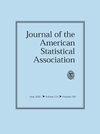反驳:LESA:大脑皮层下结构的纵向弹性形状分析
IF 3
1区 数学
Q1 STATISTICS & PROBABILITY
Journal of the American Statistical Association
Pub Date : 2023-01-02
DOI:10.1080/01621459.2022.2139264
引用次数: 1
摘要
十多年来,人们一直使用FreeSurfer (Dale & Fischl 1999)和SurfStat (Worsley et al. 2009, Chung et al. 2010)等公开可用的软件包对包括皮质和皮质下结构在内的大脑表面进行分析。Zhang等人(2022)提出了一种基于弹性形状度量的方法,用于对大脑皮层下结构进行纵向形状分析。然而,所展示的应用仅限于全球总结措施,如总表面积和主成分(PC)得分,这大大限制了研究的影响。为了分析总表面积,我们甚至不需要使用LESA来对齐结构。PC评分松散,更丰富的基于顶点的局部信息,并且不清楚海马的哪个部分负责纵向变化。一种更有效的方法是在获得LESA中的变形后,使用基于变形的形态测量(DBM)和基于张量的形态测量(TBM)进行局部形状分析(Ashburner et al. 1998,2000, Thompson et al. 2000)。考虑到弹性方法对图像变形的雅可比行列式有严格的约束(Chung et al. 2001), LESA能否有效地用于局部形状分析尚不清楚。我们将Zhang等人(2022)所做的形状分析与纵向海马研究中的DBM和TBM (Chung等人,2011)进行了对比。基于变形的形态测量(DBM)利用得到的变形场本文章由计算机程序翻译,如有差异,请以英文原文为准。
Rejoinder: LESA: Longitudinal Elastic Shape Analysis of Brain Subcortical Structures
The brain surfaces including both cortical and subcortical structures including hippocampus have been analyzed for more than a decade using publicly available software packages such as FreeSurfer (Dale & Fischl 1999) and SurfStat (Worsley et al. 2009, Chung et al. 2010). Zhang et al. (2022) proposes an elastic shape metric based method for perform-ing longitudinal shape analysis on brain subcortical structures. However, the demonstrated applications are limited to global summary measures such as the total surface area and prin-ciple component (PC) scores significantly limiting the impact of the study. For analyzing total surface area, we do not even need to align structures using LESA. PC scores loose richer vertex-based local information and it is unclear what parts of the hippocampus are responsible for longitudinal change. A more effective approach is to perform local shape analysis using the deformation-based morphometry (DBM) and tensor-based morphometry (TBM) after obtaining deformation in LESA (Ashburner et al. 1998, 2000, Thompson et al. 2000). Considering elastic methods put severe constraints on the Jacobian determinant of image deformation (Chung et al. 2001), it is not clear LESA can be effectively used in local shape analysis. We contrast shape analysis done in Zhang et al. (2022) against DBM and TBM in a longitudinal hippocampus study (Chung et al. 2011). The deformation-based morphometry (DBM) utilizes the deformation field obtained
求助全文
通过发布文献求助,成功后即可免费获取论文全文。
去求助
来源期刊
CiteScore
7.50
自引率
8.10%
发文量
168
审稿时长
12 months
期刊介绍:
Established in 1888 and published quarterly in March, June, September, and December, the Journal of the American Statistical Association ( JASA ) has long been considered the premier journal of statistical science. Articles focus on statistical applications, theory, and methods in economic, social, physical, engineering, and health sciences. Important books contributing to statistical advancement are reviewed in JASA .
JASA is indexed in Current Index to Statistics and MathSci Online and reviewed in Mathematical Reviews. JASA is abstracted by Access Company and is indexed and abstracted in the SRM Database of Social Research Methodology.

 求助内容:
求助内容: 应助结果提醒方式:
应助结果提醒方式:


